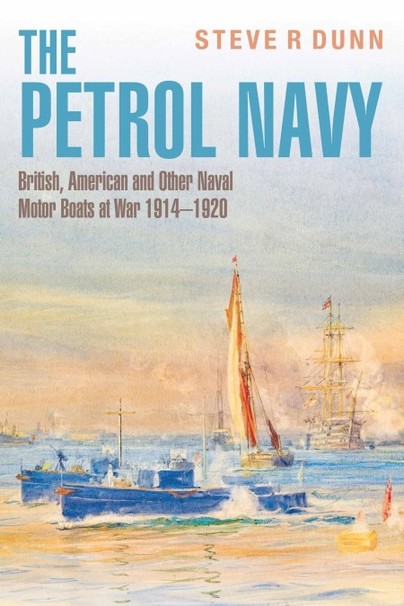
The Petrol Navy. British, American and other Naval Motor Boats at War 1914-1920. By Steve R Dunn. Seaforth Publishing, Barnsley, 2023
Reviewed by John Mortimer
This book is one in a series by the author which cover naval operations in the First World War. The current volume discusses the evolution of internal combustion engine patrol craft for coastal operations prior to, during the First World War and shortly after the cessation of hostilities in 1918.
The First Chapter titled Yachting and the Development of the Motor Boat outlines the development of the internal combustion engine, Yacht Clubs, and the evolution of petrol powered civil pleasure craft.
This is followed in Chapter 2 with a discussion of naval developments pre war, the strategic situation in Europe, and the naval response to growing concerns about the prospects of conflict. This included the acceptance of the need to requisition civilian craft for naval use in minesweeping and protection of shipping against the submarine threat. Proposals were also raised about the employment of small petrol-powered civilian craft as naval auxiliaries. This resulted in the creation of the Royal Naval Motor Boat Reserve (RNMBR) with craft operated by civilians in coastal waters in the early years of the war.
Chapter 3 discusses the early wartime employment of small craft. The trawlers, drifters, yachts, motor boats, paddle steamers and all other assorted civilian craft taken up by the Royal Navy were known as auxiliaries, and initially either joined what became known as the Auxiliary Patrol or the Minesweeping Service. Most yachts and motor boats joined the Auxiliary Patrol. At the outbreak of war, the defence of the coastline of Britain was divided into twenty-seven patrol areas, each under a senior naval officer. There were also eleven patrol areas in the Mediterranean, variously subject to British, French or Italian (after 1915) control.
By mid 1915 it was clear that the demands of naval operations had proved too much for the motor pleasure boats and that they were structurally unfitted for the task. Therefore, Chapter 4 outlines the development of the Motor Launches (MLs). This vessel was designed by the Elco Company of the USA. Over 550 vessels were built and the first commissioned into the Royal Navy from October 1915. Around the same time, the RNMBR was disestablished, and its men absorbed into the Royal Naval Volunteer Reserve (RNVR).
The Elco motor launch was primarily conceived as an anti-submarine platform. But its small draught meant that it was soon also pressed into service as both a minelayer and a minesweeper in shallow waters. These operations and the development of anti submarine weapons and sensors and minesweeping equipment in the MLs is examined in Chapter 5.
In 1915 some serving Royal Navy officers developed another concept – the hydroplaning coastal motor boat or CMB. These craft were crewed by regular Royal Navy personnel and volunteers. Some 116 of these craft were produced.
The civil crewed motor boats, MLs and CMBs, were largely employed in coastal waters performing patrol and response operations. In addition, the more heavily armed MLs and CMBs contributed to anti-submarine and mine countermeasures, as well as assisting in offensive operations, such as the Zeebrugge and Ostend raids, in concert with elements of the Harwich Force.
Chapters 6 to 15 discuss the operations of MLs and CMBs in other theatres:
- the Adriatic and Mediterranean seas, French, Belgian, US and Caribbean waters;
- the raids on Zeebrugge and Ostend;
- the operations of US, Italian, French, and German ships; and
- post war covering the Armistice, Occupation, in Russia and the North Sea.
Post-war, both MLs and CMBs saw valuable service, in the Occupation of the Rhineland, policing and defending the Rhine waterways, and in the Baltic Campaign of 1918–1920.
Britain was not alone in using diminutive motor-powered boats for war.
In Italy, the MAS torpedo-carrying motor craft achieved some success, including sinking a battleship. In France, motor launches (vedettes), supplied by the Royal Navy and acquired direct from Elco, played their part.
Germany too made use of small motor vessels, building twenty-one torpedo-armed Luftschiffmotorboote together with some Fernlenkboot remotely controlled designs.
When America entered the war, she built a considerable fleet of so-called ‘sub chasers’ specifically designed to counter the threat from U-boats. They were deployed in British and European waters just before the war’s end and post-war continued to serve with their British sisters in Europe and Russia.
These small, versatile motor craft, largely utilised in coastal waters, owed their existence to the recent development of the marine internal combustion engine, and opened new tactical opportunities for maritime powers.
“The Petrol Navy” provides a balanced assessment and evaluation of the development and evolution of small high speed motor vessels before and during the First World War. It demonstrates the utility of these ships in wartime operations, which firmly cemented their place in naval inventories. It also provides insights into why these ships were developed further during the period between the First and Second World Wars. In particular, the development and integration of weapons and sensors to suit the craft for anti-submarine and minesweeping work, as well as for offensive operations was fundamental to the importance of such ships. This was especially evident during the Second World War and in the development of high-speed strike craft from the 1950s onwards.
I thoroughly enjoyed this book and recommend it highly for all those interested in naval history and marine technological developments.



